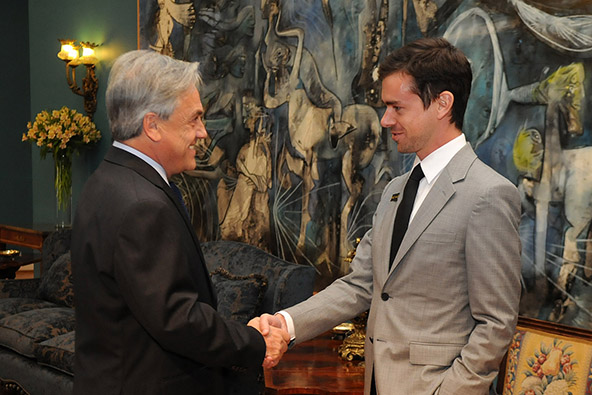Branson, Jobs, Dorsey, Societal Roadblocks and Bread and Circuses

Very early in his career Richard Branson noticed that news reporters loved to pin his grinning mugshot to articles they published about Virgin, his soon-to-become business empire. It turned out, the famous entrepreneur discovered, that people conflated his person with his business. And because he was quickly becoming a celebrity, people’s appetite for his broad, toothy smile was growing ever more insatiable. So Branson obligingly decided to give the people bread and circuses what they want and become Virgin’s face. Decades later, he is still mercilessly exploiting people’s – news reporters very much included – obsession with celebrity for business purposes. By most measures, Branson’s success has been truly extraordinary and, naturally, others have taken notice.
Enter Jack Dorsey. Judging by the volume of my daily intake of carefully arranged photos of the Twitter-famed Square co-founder, Dorsey must be spending a good chunk of his time posing for professional photographers. So much is he into the photo-shoot thing that he seems to be cultivating an image. Much as the late Steve Jobs was always to be seen wearing his blue jeans and black turtleneck, Jack Dorsey invariably sports “open-collared shirts”, as The Wall Street Journal’s Seth Stevenson helpfully describes the attire, and Dorsey does seem to share Jobs’ passion for blue jeans. And, as the experiences of both Richard Branson and Steve Jobs indicate, that is perhaps the best marketing strategy Jack Dorsey could employ. But behind the imagery it is all about business and it is all very serious.
Unblocking Societal Roadblocks
While over the years I have become accustomed to Branson’s grins and Jobs’ turtlenecks, I have never been quite able to overcome my bemusement with the sheer scale of many reporters’ adulation of these admittedly great entrepreneurs. And now that Steve Jobs is no longer with us, Jack Dorsey has begun to gradually fill his extraordinarily large marketing-savvy shoes. To give you an idea of what I mean, here is what the aforementioned Stevenson has to say on the Jobs-to-Dorsey succession at the top of the high-tech world:
With Steve Jobs gone, Dorsey has become a new focal point for those who examine the tech world through the lens of biography. As one industry reporter puts it, Dorsey seems to have inherited Jobs’s title as “the most fascinating man in tech.” But the two men differ in vital ways. While Jobs was maniacally focused on Apple’s products – he created new objects with perfect physical form and didn’t worry all that much about how people might subsequently use them to transform society – Dorsey’s vision is more top down, and of broader scope. He identifies big societal roadblocks and endeavors to unblock them.
Health care is next on Dorsey’s list of big societal roadblocks to be unblocked, we learn, and “in his head, [Dorsey] is already reinventing, beautifying and simplifying another of life’s many thorny thickets”. Am I the only one having fun with all this? But that gives us no more than a taste of Stevenson’s full potential.
Creating Beauty out of Ungainly Systems
The WSJ reporter begins his ode to Jack Dorsey by informing us of his subject’s fascination with Charlie Chaplin’s silent communication skills. Everything Chaplin does, Dorsey is quoted as saying, “serves either to further the story or for comedic effect” and no motion goes to waste, which leads him to conclude that “when you focus on the details and on efficiency of motion, something really magical happens”. As a firm believer in the power of communication and attention to detail, I couldn’t agree more with Dorsey and thought that, for once, I had stumbled upon a sensible report on Dorsey’s latest. Well, my hopes were soon crushed by the following monstrosity:
How does one person innovate in such grand fashion, then turn around and do it again? With both Twitter and Square, Dorsey’s flashes of insight are by-products of a lifelong quest for simplicity and order. Dorsey yearns to create streamlined beauty out of giant ungainly systems that at first glance appear to be irredeemably chaotic. He is the Charlie Chaplin of technologists: He makes the impossible happen through efficiency of motion.
There is no need for such a paean to someone who is merely, to misquote economist Ken Rogoff, a garden-variety hugely successful entrepreneur, not in the nation’s leading business newspaper. It is precisely when I read WSJ pieces like Stevenson’s that I’m reminded of how lucky I am to live in an age in which I have instantaneous access to the latest in the Economist and the FT on our side of the pond.
The Takeaway
Richard Branson, Steve Jobs and Jack Dorsey have one thing in common: their amazing ability to build highly successful businesses, greatly enriching themselves in the process. These businesses by definition solve people’s problems; otherwise they would never have become quite as successful. However, when examining successful entrepreneurs’ achievements, we do need to keep our feet firmly on the ground and recognize the fact that these guys are not space aliens from some much more advanced civilization than ours. What makes them different from the rest of us is mostly their ability to organize people and processes much better than their competitors (an oversimplification, I know, but it nonetheless comes as close to describing reality as we need). An entrepreneur’s success deserves celebrating and it should be studied, so that it could be more easily replicated, but the man should not be idolized.
Image credit: Businessweek.


